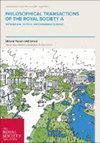VIII. On the movements of the flame in the explosion of gases.
Philosophical Transactions of the Royal Society of London Series A-Containing Papers of a Mathematical or Physical Character
Pub Date : 1903-02-04
DOI:10.1098/rsta.1903.0009
引用次数: 22
Abstract
(1.) On the Rate of Movement of the Flam, and the produced in theExplosion of Gases. Humphry Davy was the first to observe the rate at which an explosion of gases was propagated in a tube, and he also made the first rough experiment on the temperature reached in an explosion. When gas from the distillation of coal (which he found more inflammable than fire-damp) was mixed with eight times its volume ofair, and was fired in a glass tube 1 foot long and 1/4 inch in diameter, the flame took more than a second to traverse the tube. When cyanogen mixed with twice its volume of oxygen was fired in a bent tube over water, the quantity of water displaced showed that the gases had expanded fifteen times their original bulk. Bunsen, in 1867, made the first careful measurement of the rate at which an explosion is propagated in gases, and he also made the first systematic researches on the pressure and temperature produced by the explosion of gases in closed vessels. His results led him to the remarkable conclusion that there was a discontinuous combustion in explosions. When electrolytic gas, or when carbonic oxide with haltits volume of oxygen, is fired, only one-third of the mixture is burnt, according to Bunsen, raising the temperature of the whole to about 3000° C. No further chemical action then occurs until the gaseous mixture falls, by cooling, below 2500° C. Then a further combustion begins, and so onper Saltum. These deductions were criticised by Berthelot, who pointed out that they assumed the constancy of the specific heats of steam and of carbonic acid at high temperatures.8关于气体爆炸时火焰的运动。
(1)。论火焰的运动速度和气体爆炸时产生的火焰。汉弗莱·戴维是第一个观察到气体在管中爆炸传播速度的人,他还对爆炸达到的温度做了第一个粗略的实验。把煤蒸馏出来的气体(他发现煤比湿气更易燃)与8倍于其体积的空气混合,然后在一个1英尺长、1/4英寸直径的玻璃管中燃烧,火焰穿过管子需要1秒多的时间。当把混合了两倍体积氧气的氰放在一个弯曲的管子里,在水上面燃烧时,排开的水的数量表明,这些气体膨胀了15倍于原来的体积。1867年,本生第一次对爆炸在气体中传播的速率进行了仔细的测量,他还第一次系统地研究了密闭容器中气体爆炸产生的压力和温度。他的结果使他得出了一个了不起的结论,即爆炸中存在不连续的燃烧。根据本生的说法,当电解气体或含氧量为一半的一氧化碳燃烧时,只有三分之一的混合物被燃烧,将整个混合物的温度提高到3000℃左右。直到气体混合物冷却到2500℃以下,才会发生进一步的化学反应。然后开始进一步燃烧,Saltum也是如此。这些推论受到贝特洛的批评,他指出,这些推论假定蒸汽和碳酸在高温下的比热是恒定的。
本文章由计算机程序翻译,如有差异,请以英文原文为准。
求助全文
约1分钟内获得全文
求助全文
来源期刊
自引率
0.00%
发文量
0

 求助内容:
求助内容: 应助结果提醒方式:
应助结果提醒方式:


